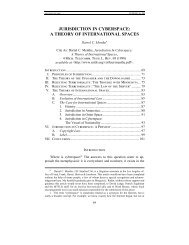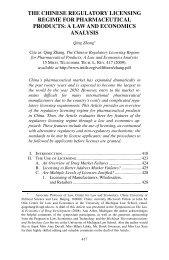Fracking Patents - Michigan Telecommunications and Technology ...
Fracking Patents - Michigan Telecommunications and Technology ...
Fracking Patents - Michigan Telecommunications and Technology ...
- No tags were found...
Create successful ePaper yourself
Turn your PDF publications into a flip-book with our unique Google optimized e-Paper software.
Spring 2013] <strong>Fracking</strong> <strong>Patents</strong> 303required for the exploitation of shale <strong>and</strong> other unconventional gas reservoirsbring with them a spectrum of distinct <strong>and</strong> significant environmental <strong>and</strong>health hazards. 143 “From the first day the drill bit is inserted into the grounduntil the well is completed, toxic materials are introduced into the borehole<strong>and</strong> returned to the surface along with produced water <strong>and</strong> other extractionliquids.” 144 Along the way, each well produces hundreds of tons of drill cuttings<strong>and</strong> thous<strong>and</strong>s of gallons of slops, much of it highly toxic. 145 For instance,“many of the fracking additives are toxic, carcinogenic ormutagenic.” 146 Similarly, “current fracture diagnostic technology uses radioactivematerials which can pose a high risk from a health, safety <strong>and</strong> environmentperspective . . . . [T]he potential to cause pollution or long termdetrimental health problems are great.” 147 There are also considerable l<strong>and</strong>use changes such as drilling pads, pipelines <strong>and</strong> compressor stations, alongwith numerous other potential community impacts such as truck traffic, temporaryworkers, <strong>and</strong> stresses related to drilling <strong>and</strong> fracking. 148 Given thebreadth <strong>and</strong> complexity of these issues, stakeholders have raised numerousquestions about potential environmental, safety, <strong>and</strong> health hazards. 149First, environmental hazards include issues such as acute <strong>and</strong> chronicaquatic toxicity, bioaccumulation, biodegradation, endocrine disruption,ozone depletion, volatile organic compounds (“VOCs”), <strong>and</strong> the use ofchemicals considered “priority pollutants” by the Environmental ProtectionAgency (“EPA”). 150 Despite the fact that many of these chemicals are“highly toxic,” such additives are “critical to the success of hydraulic water-143. WILLIAMS, supra note 56, at 9; Andy Jordan et al., Quantitative Ranking MeasuresOil Field Chemicals Environmental Impact 1 (Soc’y of Petroleum Eng’rs, SPE 135517, 2010),available at http://www.spe.org/atce/2010/pages/schedule/tech_program/documents/spe1355171.pdf; S<strong>and</strong>ers et al., supra note 142, at 1–3.144. Theo Colborn et al., Natural Gas Operations from a Public Health Perspective, 17HUM. & ECOLOGICAL RISK ASSESSMENT 1039, 1053 (2011).145. Pete Morrison, Meeting the Environmental Challenge with <strong>Technology</strong> 1 (Soc’y ofPetroleum Eng’rs, SPE 143837, 2011), available at http://www.onepetro.org/mslib/servlet/onepetropreview?id=SPE-143837-MS.146. Howarth & Ingraffea, supra note 140, at 477.147. Mark Mulkern et al., A Green Alternative for Determination of Frac Height <strong>and</strong>Proppant Distribution 1 (Soc’y of Petroleum Eng’rs, SPE 138500, 2010), available at http://www.onepetro.org/mslib/servlet/onepetropreview?id=SPE-138500-MS.148. WILLIAMS, supra note 56, at 10, 14–16; Roxanna Witter et al., Potential Exposure-Related Human Health Effects of Oil <strong>and</strong> Gas Development: A White Paper 13–15 (Sept. 15,2008), available at http://docs.nrdc.org/health/files/hea_08091702a.pdf.149. Daniel J. Soeder, The Marcellus Shale: Resources <strong>and</strong> Reservations, 91 EOS 277,278 (2010).150. Brannon et al., supra note 141, at 3; Harold D. Brannon et al., The Quest to ExclusiveUse of Environmentally Responsible Fracturing Products <strong>and</strong> Systems 3 (Soc’y of PetroleumEng’rs, SPE 152068, 2012), available at http://www.onepetro.org/mslib/servlet/onepetropreview?id=SPE-152068-MS; Jordan et al., supra note 143 at 1, 3; S<strong>and</strong>ers et al., supra note142, at 3. Currently, the EPA regulates <strong>and</strong> has developed analytical test methods for 126Priority Pollutants. 40 C.F.R. § 423 app. A (2012).






